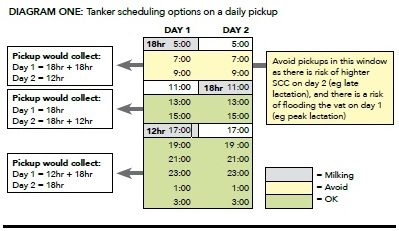It seems cows are as happy as their humans to have a few sleep-ins each week, based on the initial results of a flexible milking time study at the Lincoln University Research Dairy Farm (LURDF).
DairyNZ senior farm systems scientist Dr Paul Edwards has been running the three-year study looking into the effects of three milkings in two days (three-in-two) on people, cows and farm systems.
More flexibility with milking times could have far reaching effects for staffing; increasing the pool of available staff, lightening workload and increasing the attractiveness of the industry.
As part of this year’s work four, 29-cow farmlets are being compared.
On one farmlet the cows are being milked twice-a-day throughout this season while on another the cows are milked three-in-two for the whole season at a 12, 18 and 18-hour intervals.
On the other two farmlets cows are milked twice-a-day for the first part of the season and then, for one farmlet, milked three-in-two from December 1.
On the other the switch to three-in-two begins on March 1.
To date the preliminary data shows minimal milk production losses with three-in-two, Paul says.
“In spring, cows milked three-in-two produced 10% less milk but had a greater milksolids (MS) percent – 9.6% versus 9% for three-in-two and twice-a-day respectively – which suggests 4% less MS.”
The same milk yield and MS effect looks to have occurred over summer too for both the full season three-in-two cows and the cows switched to three-in-two on December 1.
Somatic cell count (SCC) is up slightly in the three-in-two herd so far this season but overall all herds are low and there doesn’t appear to have been a difference in the incidence of mastitis.
The experiment at LURDF is ongoing and those interested can sign up to receive a fortnightly update on progress at www. dairynz.co.nz/3in2
A full farm systems analysis will be carried out at the end of the season.
Interviews have been carried out with 12 farmers already using three-in-two in various ways, farm systems and regions.
Early results from the interviews show farmers have come up with numerous ways to get around issues associated with tanker scheduling, mating and grazing management.
If the tanker comes on a daily pick-up a good option is to have the tanker come after the11am (ish) milking, depending on vat size, to prevent potential flooding during peak lactation and higher SCC and low volume on day two.
Options for mating include:
- Mate after every milking – where AI technician can be flexible with timing.
- Mate at the same time each day:
- If mating after the AM milking, then cows to put up on day two would be selected at the PM milking on day one and grazed separately.
- If mating after the 11am milking, cows to put up on day one would be selected at the AM milking on day one and grazed separately.
- If mating after the PM milking, then cows to put up on day two would be selected at the 11am milking and grazed separately.
- Mate after the AM milking on day one and 11am milking on day two.
- Where the AI technician was flexible to come at slightly different times and to avoid the hassle of having a separate AI mob every second day.
The general consensus from interviewed farmers on grazing management is to think about allocation on a 48-hour basis instead of 24-hour as it can be easy to overcomplicate systems.





